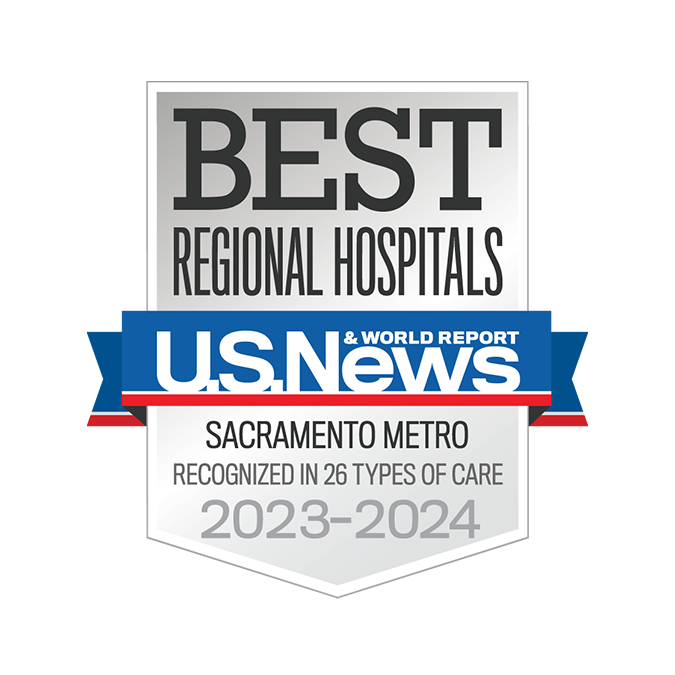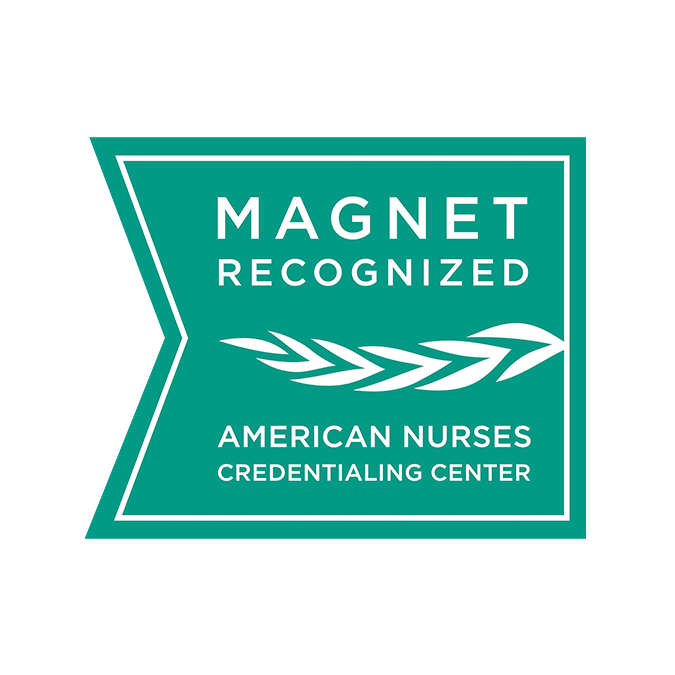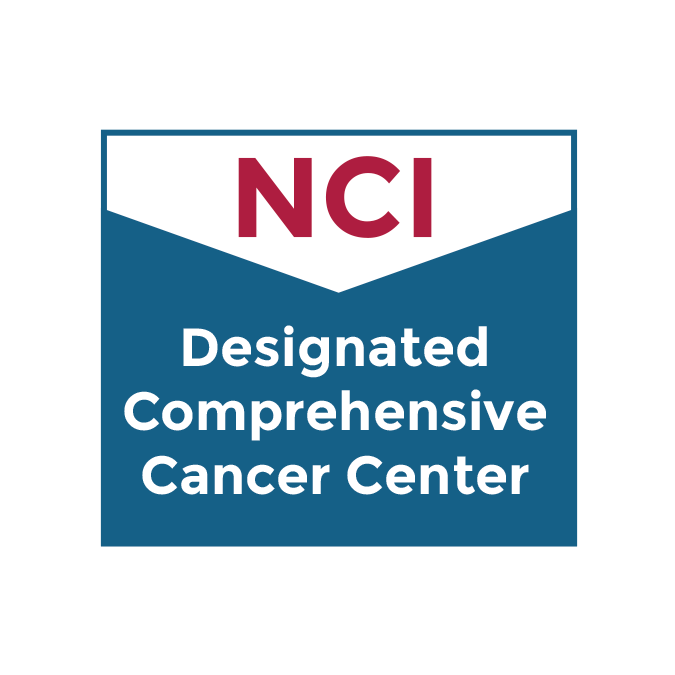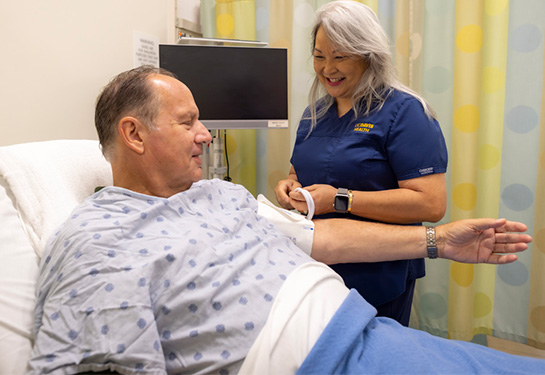Thoracic Outlet Syndrome
Thoracic outlet syndrome can cause swelling, pain and discomfort. Our specialists offer a range of treatments to help you find relief.
Medically reviewed by Misty Humphries, M.D. on June 21, 2023.

Leading Care for Thoracic Outlet Syndrome
At UC Davis Health, we provide expert care for all types and combinations of thoracic outlet syndrome. Specialists across our health system work together seamlessly to meet your unique needs.
Understanding Thoracic Outlet Syndrome
Thoracic outlet syndrome is a narrowing in the space above your first rib. When this area closes, it can create a tighter space for nerves and blood vessels to travel through.
Thoracic outlet syndrome develops when the passageway becomes too narrow, and the blood vessels or nerves in your thoracic outlet are squeezed (compressed). This compression causes pain, numbness and other symptoms in your arm and hand.
The three types of thoracic outlet syndrome are:
- Neurogenic thoracic outlet syndrome: This type affects a group of nerves running from your spinal cord to your shoulder, arm and hand (brachial plexus). Neurogenic thoracic outlet syndrome (most common) makes up more than 90% of cases.
- Venous thoracic outlet syndrome: This type involves compression of a vein passing through your thoracic outlet, which can cause blood clots.
- Arterial thoracic outlet syndrome: This type occurs when bones of the thoracic outlet press on an artery, restricting blood flow. Increased pressure in the narrowed artery can cause a bulge in your artery wall (aneurysm).
You can develop more than one type of thoracic outlet syndrome if your bones compress more than one structure.
Symptoms of Thoracic Outlet Syndrome
Symptoms vary between the types of thoracic outlet syndrome. Your symptoms may be constant or occur with certain movements or postures.
Common Symptoms of Neurogenic Thoracic Outlet Syndrome:
- Ache or pain in your shoulder or arm
- Numbness or tingling in your fingers or hand
- Weakness in your arm or hand
Symptoms of Venous Thoracic Outlet Syndrome:
- Arm Weakness
- Tingling, pain, or numbness in your arm or hand
- Swelling or heaviness of your arm
Common Symptoms of Arterial Thoracic Outlet Syndrome:
- Ache, tingling or numbness in your hand or arm
- Cool hand or fingers
- Paleness or bluish tint in your fingers or hand
Causes of Thoracic Outlet Syndrome
Common causes of thoracic outlet syndrome include:
Congenital Anomalies
Congenital anomalies are structural differences present at birth, such as an extra rib or muscle.
Repetitive Movements
Repeated motion of your arm or shoulder, especially during sports or job-related activities, can increase your risk.
Poor Posture
Consistent poor posture, such as slouching or holding your neck forward, can increase your risk.
Traumatic Injury
You may develop thoracic outlet syndrome after a traumatic injury to your neck or shoulder, such as whiplash.
Tumor or Cyst
A tumor or cyst in your neck or upper chest can put pressure on blood vessels and nerves.
Thoracic Outlet Syndrome Risk Factors
Risk factors are things that increase your chances of developing thoracic outlet syndrome. Possible risk factors include:
Biological Sex
Women are more likely to develop thoracic outlet syndrome than men.
Overweight and Obesity
Having excess weight on your body may place extra stress on your collarbone and increase your risk of thoracic outlet syndrome.
Poor Muscle Development
Weak muscles in your shoulder, neck or chest may not support your collarbone, causing it to move closer to the first rib underneath.
Diagnosing Thoracic Outlet Syndrome
Diagnosis starts with a review of your symptoms and a physical exam. Your physician may try to trigger your symptoms by asking you to move your arms or head in specific ways.
Other tests your physician may order to diagnose thoracic outlet syndrome or rule out other conditions include:
- Medical imaging tests, such as X-ray, ultrasound, CT and MRI, to look at your bones, muscles, tendons and blood vessels.
- Electrodiagnostic tests, including electromyography and nerve conduction studies, to measure electrical activity in your nerves and muscles.
- Blood vessel studies, such as angiography (arteries) and venography (veins). Your physician inserts a thin, flexible tube (catheter) into your blood vessels to look for blood clots or aneurysms.
Thoracic Outlet Syndrome Treatments at UC Davis Health
Treating thoracic outlet syndrome requires a specialized team approach. Your care team may include:
- Heart and blood vessel (vascular) specialist
- Musculoskeletal (orthopaedic) specialist
- Physical therapist
- Chest (thoracic) surgeon
- Blood vessel surgeon
With a skilled team guiding your care, treatment is usually very effective.
Physical Therapy
Physical therapy can help relieve nerve and blood vessel compression by strengthening your chest and neck muscles and improving your posture.
Find out more about our Department of Physical Medicine and Rehabilitation
Lifestyle Changes
You may need to adjust your lifestyle to avoid repetitive or strenuous activities that cause symptoms or make them worse.
Medications
Your physician may prescribe nonsteroidal anti-inflammatory drugs (NSAIDs) to ease swelling (inflammation) and pain. Other medications can break up blood clots that may cause symptoms or prevent new blood clots from forming.
Thoracic Outlet Syndrome Surgery
Your specialist may recommend surgery to widen the thoracic outlet if other therapies are not effective. A vascular surgeon may remove part of your first rib and scalene muscle in your neck to improve circulation and alleviate pain.
Blood Vessel Surgery
If you have damage to a vein or artery, you may have blood vessel surgery at the same time as chest surgery. The surgeon may remove a blood clot or replace a damaged section of your artery with a fabric tube (graft).
Read more about our leading-edge approach to vascular and endovascular surgery
Preventing Thoracic Outlet Syndrome
You can’t always prevent thoracic outlet syndrome, but reducing pressure on your thoracic outlet can help. Practice good posture and avoid carrying heavy bags over your shoulder.
It’s also important to keep the muscles in your neck, shoulders and chest strong and flexible. Ask your physician for stretching and strengthening exercises that you can do at home.
Who does it affect?
3-80 in 1KPeople diagnosed with thoracic outlet syndrome each year
Source: NIH/StatPearls: Thoracic Outlet Syndrome
Request an Appointment
As Sacramento's No. 1 hospital, you'll benefit from unique advantages in primary care and specialty care. This includes prevention, diagnosis and treatment options from experts in 150 specialties.
Referring Physicians
To refer a patient, you can submit an electronic referral form or call.
800-4-UCDAVIS
Patients
For questions and appointment information
Consumer Resource Center
800-2-UCDAVIS

Ranked among the nation’s best hospitals
A U.S. News & World Report best hospital in cancer, cardiology, heart & vascular surgery, diabetes & endocrinology, ENT, geriatrics, neurology & neurosurgery, obstetrics & gynecology, and pulmonology & lung surgery.

Ranked among the nation’s best children’s hospitals
A U.S. News & World Report best children’s hospital in diabetes & endocrinology, nephrology, and orthopedics*. (*Together with Shriners Children’s)

Ranked Sacramento’s #1 hospital
Ranked Sacramento’s #1 hospital by U.S. News, and high-performing in COPD, colon cancer surgery, diabetes, heart attack, heart failure, hip fracture, hip replacement, kidney failure, leukemia, lymphoma & myeloma, lung cancer surgery, ovarian cancer surgery, pneumonia, prostate cancer surgery, stroke, TAVR, uterine cancer surgery, gastroenterology & GI surgery, and orthopedics.

The nation’s highest nursing honor
UC Davis Medical Center has received Magnet® recognition, the nation’s highest honor for nursing excellence.

“Most Wired” for acute care
UC Davis Health has been recognized as a level 10 out of 10 in the Digital Health “Most Wired” program from the College of Healthcare Information Management Executives (CHIME). The honor recognizes excellence in using technology to improve the delivery of care.

“Most Wired” for ambulatory care
UC Davis Health has been recognized as a level 10 out of 10 in the Digital Health “Most Wired” program from the College of Healthcare Information Management Executives (CHIME). The honor recognizes excellence in using technology to improve the delivery of care.

World-class cancer care
One of ~56 U.S. cancer centers designated “comprehensive” by the National Cancer Institute.

A leader in health care equality
For the 13th consecutive year, UC Davis Medical Center has been recognized as an LGBTQ+ Healthcare Equality Leader by the educational arm of America’s largest civil rights organization.

